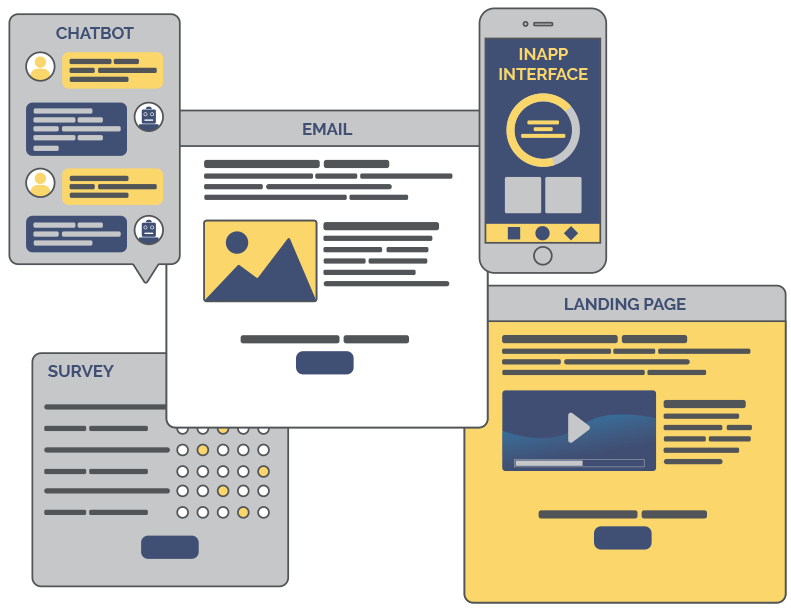Most potential clients do not wake up in the morning thinking - where can I find a new innovative solution to my problem? They prefer a solution they already know and trust. Even if that solution is bad. It doesn’t matter if you are selling something better, faster and at a fraction of the cost. In some cases that is even worse - how could it be true? Wouldn’t everyone be doing it? Your problem is that they don’t trust you.
Build trust over time
What you need is a tactic to build trust over time. For a new buyer, choosing your product is a more complicated decision than most are able to make after hearing about it once. Put yourself in the buyers shoes. Want to change from a horse-drawn carriage to an automobile? Want to take a ‘risk-free’ space cruise to Jupiter and Mars? “All you need to do is press here!” And, would you press a button you did not fully trust? No, you wouldn’t. Our tests show that creating the trust you need for someone to choose a new solution to an old problem, may require eight touch points with your potential clients. Working with leads is a tactic to deliver those touch points to people who are not already looking for your solution.
Lead Generation vs. Lead Nurturing
Where would you have to start to find more clients? You would have to know their names. And equally important - know what to say when striking up a conversation with them, so they want to keep a dialogue going with you. There are two phases of working with leads. 1. Generating contact information of people who identify themselves to you and 2. nurturing that contact with valuable communication until you have gained enough trust from them to buy something from you. Here is a hint: You can’t just talk about yourself. Remember that they aren’t ready for that yet. You need to share knowledge or inspiration at every touch point and use mechanisms that will collect emails and names for you.
Here are seven tactics to get potential clients to trust and care about what you have to say. Another tip: They’re all about good content. And they provide a data-driven approach to getting new leads. If your specific content or tactic is not working, the numbers will tell you, as well as give clues on what you should do more of.
7 ways to attract more potential clients
1. Squeeze Page
This is a landing page designed to squeeze out contact information of leads. Potential clients will give you their contact information, if you offer valuable content in return. This can be a white paper or something useful. It should be valuable enough to create a fear of missing out (FOMO), and make them happy to accept hearing more from you in the future.
2. How-to-guides
Tell your segment how to solve a problem that is important for them. One they go online to find a solution for, but one that is not solved by your solution directly. Then you would just be selling your product and they’re not ready yet. The benefit for you is relevant users will come to your site for a solution and leave feeling helped by you. The prerequisite for this is using relevant keywords in your article and url. Length: 800 words.
3. Long-reads
Explain important ideas within your field of expertise. Could your industry work in a better way? Again, do not fall into the trap of explaining your own product. You are trying to give away valuable insight. Don’t be afraid to voice opinions or start debates. You want people to notice you. This form of article can mimic a feature in Rolling Stone Magazine or other weekend supplements. Length: 3000 words.
4. Events
Invite other thought leaders to talk at a seminar hosted by you on a subject important for your clients or industry. Make people sign up by email and ask for permission to send them a newsletter if they do.
B2B Bonus tip: Invite potential customers to speak about their own solution to an audience you provide. Afterwards, they are likely to become your clients.
5. Drip Campaigns
Use automated email tools to communicate with potential customers over time. You are not spamming them, you are trying to start a dialogue valuable enough for them to actually want to join into. The content should be as valuable as the articles mentioned above, by giving insight or inspiration. Lead scoring tools can be used to help you identify the people who are most likely to be ready for a sales pitch. Even better, a reply to your email should be treated to a swift and keen response to any question.
The most important rule of email is that people don’t care about you - and what you are sending until you show you care about them. So segment your emails properly.
Click here to read about Email marketing.
6. Surveys
Asking someone’s opinion is a powerful tool for engaging people. But in this case you actually want to hear from them - so you may learn more about what they want. Engage leads this way by asking them what they think about a relevant industry issue.
7. Social media presence attracts feedback
A presence in social media is almost a given. Many people think social media is there for them to talk to potential clients. What happens is that they use it to talk to you. Listen when this happens and treat people that get in touch with you as if they come bearing gifts.
To conclude
All these tactics build data that teaches you what your potential clients - or leads - are actually looking for. And the work of finding your leads and nurturing them can be automated. If you do this, you will have a machine that finds potential clients for you while you free up time to do other important work for your business. It will not get them totally hooked, but they will be totally interested. Getting them addicted starts next, when they’ve said yes - using onboarding tactics.
Follow us on for more!






